Hursley Park's Grounds and Gardens
For centuries, English parks and gardens in both landscaped and formal forms have been the admiration and envy of many foreign visitors. The overall aesthetic appeal owes much to England’s temperate climate but, surprisingly, despite this moderate climate and good annual rainfall, many trees and shrubs from such harsh environments as the north of North America or Russia’s Siberia do not survive. This is due to the unpredictable changes in the weather that can occur throughout the year.
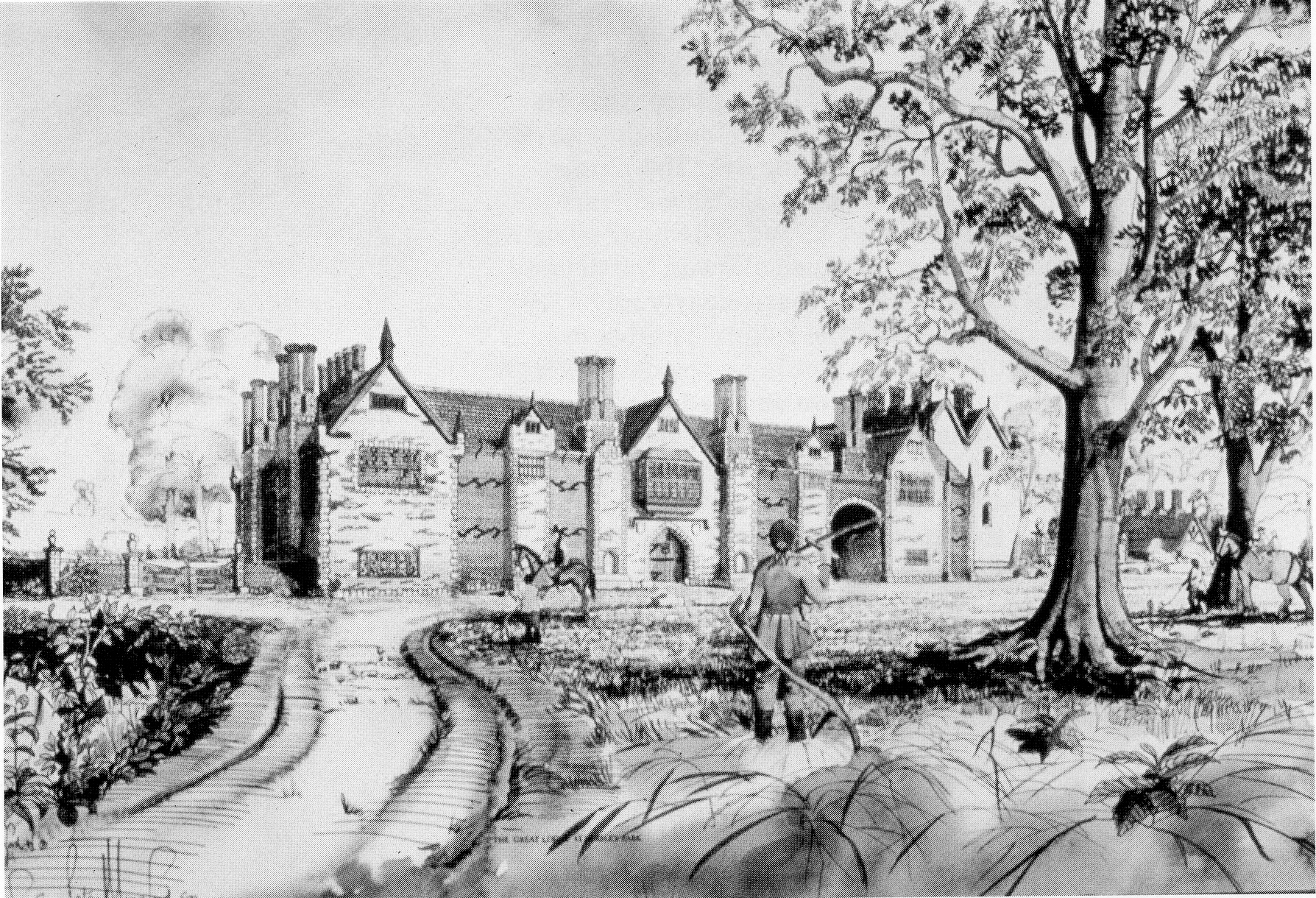 Conjectured appearance of Great Lodge, by Peter Mumford, 1983.
Conjectured appearance of Great Lodge, by Peter Mumford, 1983.
Compared with other parts of the world, Great Britain does not have four clearly divided seasons. In other countries, when winter ends, spring proceeds with no real interruptions through to summer, on to autumn, and back again to winter. In Great Britain, the Gulf Stream can bring very warm periods into January’s ice and snow, which can happen several times during a winter period. Even in summer, winter temperatures can cut in with ground frosts at night. All this plays havoc with imported plants, especially those from harsh climates, whose genetic make up causes them to trigger into new life with warm days in winter, unable to stop or retract when temperatures plummet again. Should such a plant survive one reversal of temperatures, the next can invariably be ‘the last straw’. It is in part due to the ways the English flora has adapted and performs so magnificently in spite of this often overlooked handicap, that admiration and respect is deserved.
Historically, man has been working this land for well over two thousand years since the old Manor of Merdon on the Merdon Castle site, for both arable and stock farming. It is from this land south of the Castle that Hursley takes its name (see first chapter). Gardens have existed on this site from around 1560, belonging to the Tudor lodge of 1553, whose footings still show up in dry summers on the bowling green to the south of the present house. The Lodge had an enclosed square walled garden of approximately one acre on the south side, but to date no information on the layout, contents or appearance have been found. The illustration on the opposite page is taken from an ink and watercolour painting of the lodge of the 15th century, which is a fair conjectured impression of the overall appearance of this house viewed from the north east. Walls built of brick for walled-in gardens were found to be best, having in particular one great advantage over other walling materials, besides being effective in keeping out animals (in Hursley’s case deer) and shelter from winds, the wall was an effective night storage heater for fruit trees and bushes growing against it. The warmth of the Sun on a south facing wall is held over well into the night to such an effect that the temperature of sheltered still air by such a wall can average five degrees Celsius above the open air temperature in the rest of the garden. Even a one degree advantage could be enough to protect blossom from frost damage.
To get an understanding and perspective of the gardens at Hursley Park, the geology and history of the site needs to be taken into account. The Park House stands some 800 feet (250 m) to the north of a major geological divide. The chalk strata that is under the House abruptly disappears deep underground under a ridge beyond the southern end of the south lawn, and only surfaces again on the other side of the Solent 0n the Isle of Wight. The surface evidence of this dramatic change in sub soils is seen in the plants of the hedge rows and in the Rhododendrons which do not like chalk soils, that are found to the south of this ridge in the park and at Ampfield, but are generally not evident on the chalk loam to the north. The heavy clay subsoil below this ridge, where the Sports Field is, underlines this dramatic change. On the higher ground at Ampfield the soil is Bagshot sand over clay.
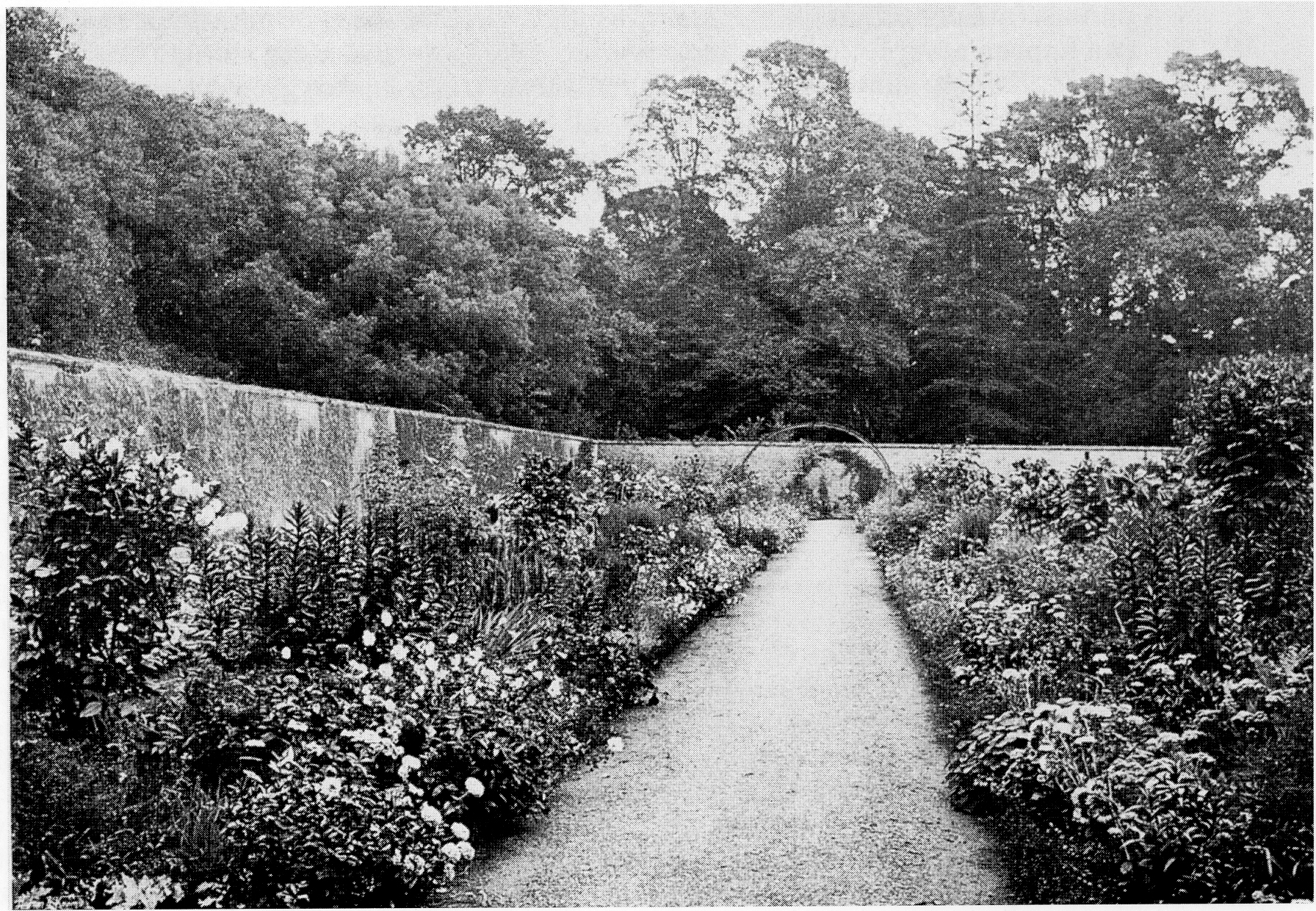 Walled Garden
Walled Garden
When the centre portion of the present Hursley House was built around 1721, some of the current features of the layout of the grounds were laid down, which have been maintained and enhanced right through to present times. As with the old Tudor Lodge the new house had a walled garden, but this time it was rectangular, enclosing some three acres, and was sited off the south east corner of the House. Within this enclosure in the early part of the twentieth century were formal gardens of flower beds and shrubberies divided by grass walks. A tennis court was added around 1910. The kitchen garden was outside the southern end of the walled garden, out of sight of the principal rooms in the House, and was able to take advantage of the south side wall. The garden wall was some 10 feet (3 m) high and, aided by falling ground to the south, was also sufficient to screen from the House green houses, sheds and the head gardener’s flat- roofed bungalow. The drive that went down to the church and village from the House was a turfed ride within an avenue of walnut trees, of which only one or two now survive, and the line of this avenue is now lost.
In the late summer of 1856, the American lawyer and author Richard Henry Dana was a guest at Hursley Park, and he wrote of his ‘ visit‘. . . laying down on the soft turf, under a spreading and deep leafed oak tree, there are no mosquitoes, or other plaguing insects as at home, but one may lie at ease, on turf as smooth and soft as carpet, undisturbed to contemplate and enjoy this mixture of wildness and cultivation that marks an English Park. Here is nice attention to turf and trees while by your side are deer, and overhead are the circling and cawing innumerable crows and choughs . . . The Church and the village of Hursley is at the Park gate, only about ten minutes walk from the House, and this walk is over smooth turf under the deep shade of trees . . . ’ (the walnut avenue).
 The walnut avenue
The walnut avenue
In 1902, the magazine ‘Country Life’ featured Hursley Park House and grounds as they were for most of the nineteenth century, showing many of the Park’s views and the walled garden. The photo on, page 42 shows one of the views taken then, but not used in the article. It is the principal aspect viewed from the south west, with a dovecote in the foreground.
When the House was extensively remodelled in 1902—1903, the existing layout of the grounds was retained and greatly enhanced. The Japanese sunken garden with an avenue of fruit trees continuing south, featuring an ornamental lead water tank at its centre, was constructed before the First World War, and a spectacular rock garden, backed up with banks of rhododendrons, was created in the area of the present rifle range. The garden plan shows the layout of the gardens at that time, which has influenced the development of this site and the maintenance of existing views ever since. A lot of these features can still be seen in spite of the many changes that have taken place, even down to the course of many of the paths. Prior to the First World War some fifteen gardeners were employed creating and maintaining these grounds to very high standards, so that every aspect always pleased the eye.
The period of 1902 to 1940 was the swan song of Hursley Park as a private residence, and was captured in 1910 by Sir Phillip Burne- Jones’s delightful painting of the Japanese sunken garden. Another Burne—J ones painting (not shown) depicts the herring bone brick path that went from the walled garden across the south side of the House, with lovely flowering borders in the foreground. In 1909, ‘Country Life’ visited Hursley Park again and the photographs from this halcyon period Show that some things, happily, have not changed too much.
In 1925, the landscape architect Gertrude Jekyll (who worked with the famous architect Sir Edwin Lutyens) was asked for her help in enhancing the contents of the formal Hursley gardens. She supplied lists of flowers with drawings based on a rather large drawing sent by the estate carpenter. She was also asked for suggestions about the gardens at Merdone Manor, but this time to rather smaller drawings. It appears that the lady was never able to Visit Hursley'to see her proposals put into practice.
On leaving Hursley for Winchester, the road between Standon Farm and Pitt enjoys a particularly beautiful backdrop of variegated trees on the hill, beyond the field on the south side. This beautiful wood is the result of having a ‘tree bank’ for Hursley Park, as a back up, should any of the Park’s trees become diseased or not survive. This legacy from the early part of this century is serenely picturesque during the autumn, and justifies the adjacent lay—by for motorists to enjoy this panoramic View of unusually colourful foliage.
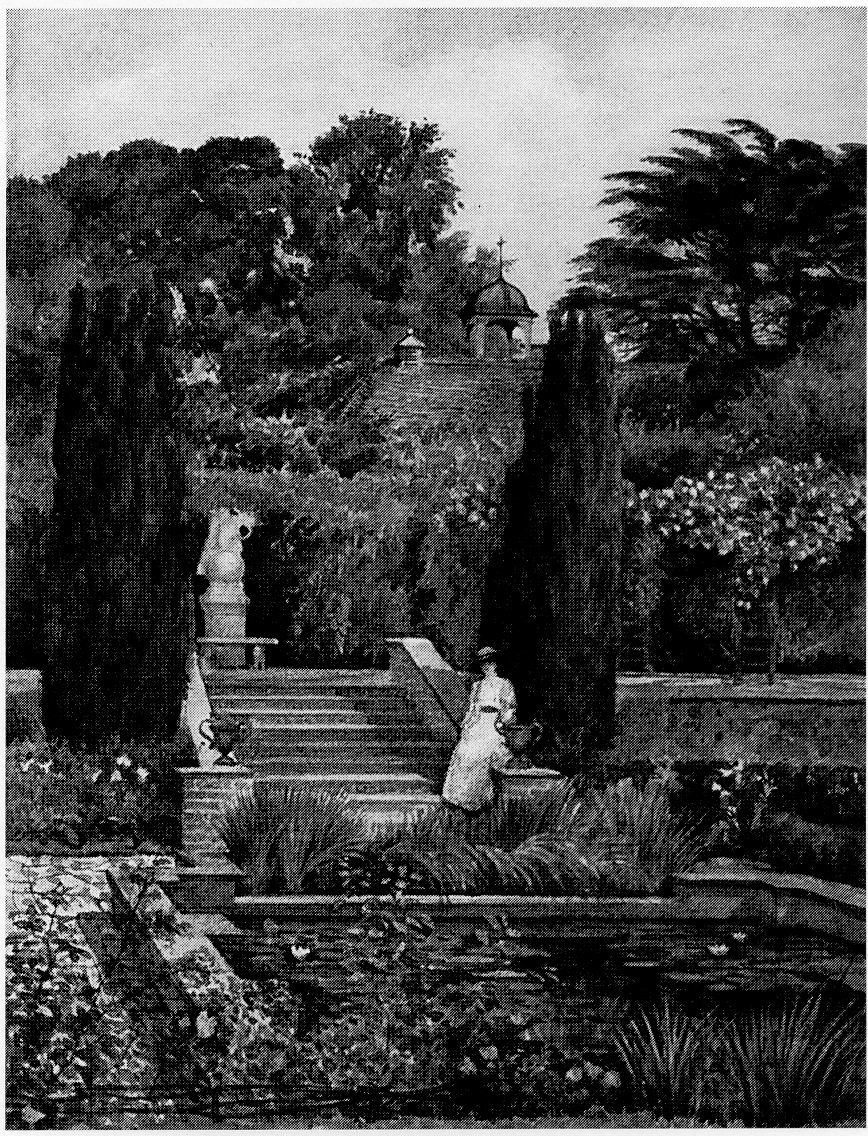 Japanese garden by Philip Burma-Jones
Japanese garden by Philip Burma-Jones
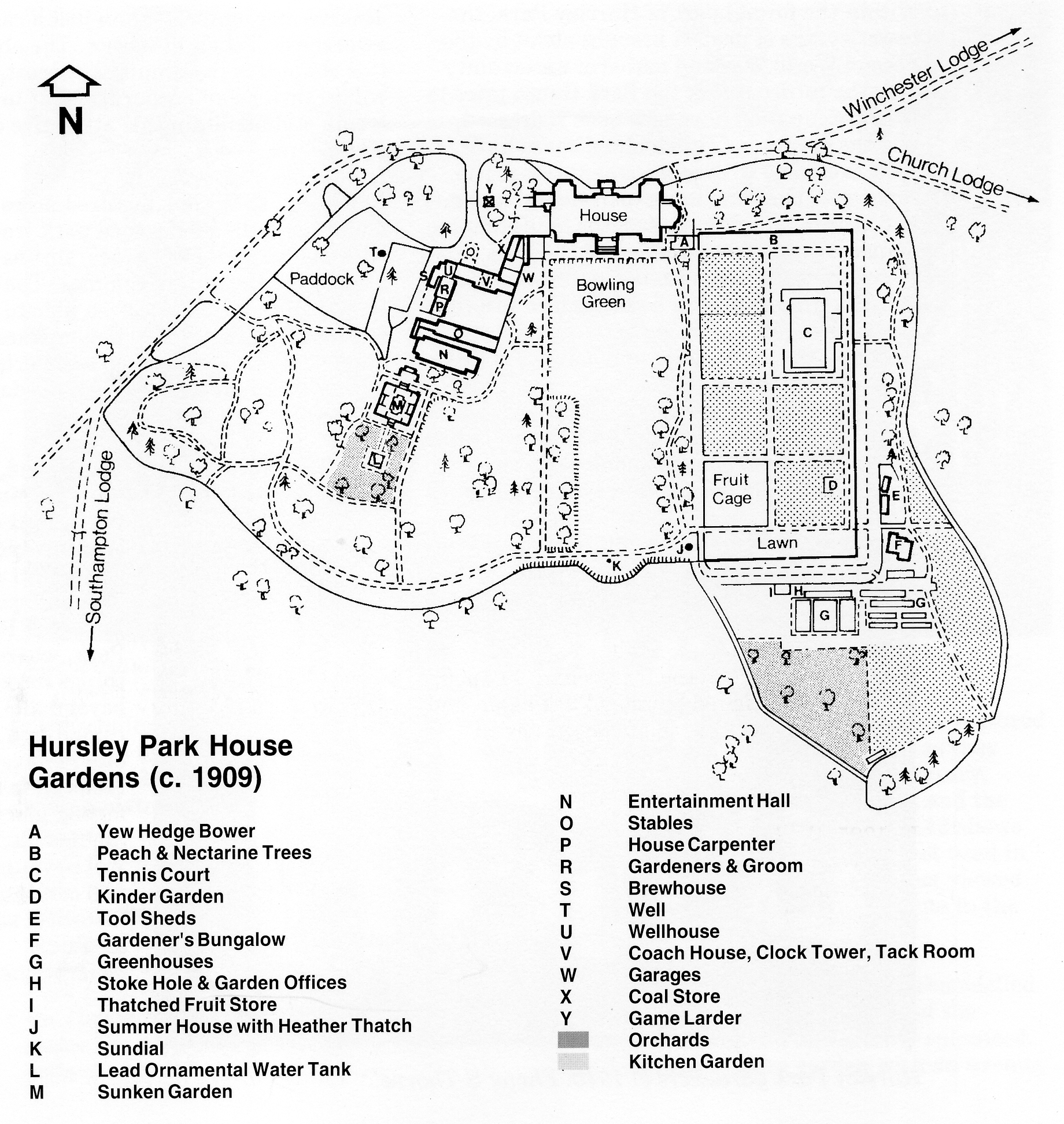 Hursley Park House Gardens (c. 1909)
Hursley Park House Gardens (c. 1909)
Within the formal part of Hursley Park, the twenty years of neglect brought about by the Second World War and period of uncertainty over the future role of the Park House prior to IBM’s occupation have now been redressed, and the ravages of Dutch elm disease have been overcome with replacement trees. The removal of the war time experimental hangars and ancillary buildings from the Southampton Lodge area in 1989 has allowed the Park to revert to its former state there. Preservation of the mature trees has been the first priority and considerable planting of new trees is restoring the appearance and balance of this English park scene.
As the development of this laboratory site has matured, beds of shrubs and flowers have been created around the new buildings, which deserve more interest than just a casual awareness of their existence. The object of this chapter is to stimulate interest, which will in turn be an encouragement to those who create and maintain this attractive corner of Hampshire.
Generally, IBM’s one hundred acres have maintained the landscaped park tradition with many interesting trees, shrubs and views around the laboratory complex. The one formal garden that has been able to be retained and restored is the Japanese sunken garden, which is now close to its original appearance in the Edwardian heyday of this country house around 1910.
Complete with Koi carp in the pond, and plants that will delight the eye at any time of the year, it’s an ideal spot in which to sit and reflect upon the long and varied history of Hursley Park, where some things have changed beyond all recognition, while others have been restored to their former glory. A few landmarks, we hope, will never change and will continue to be historical sign posts for future generations.
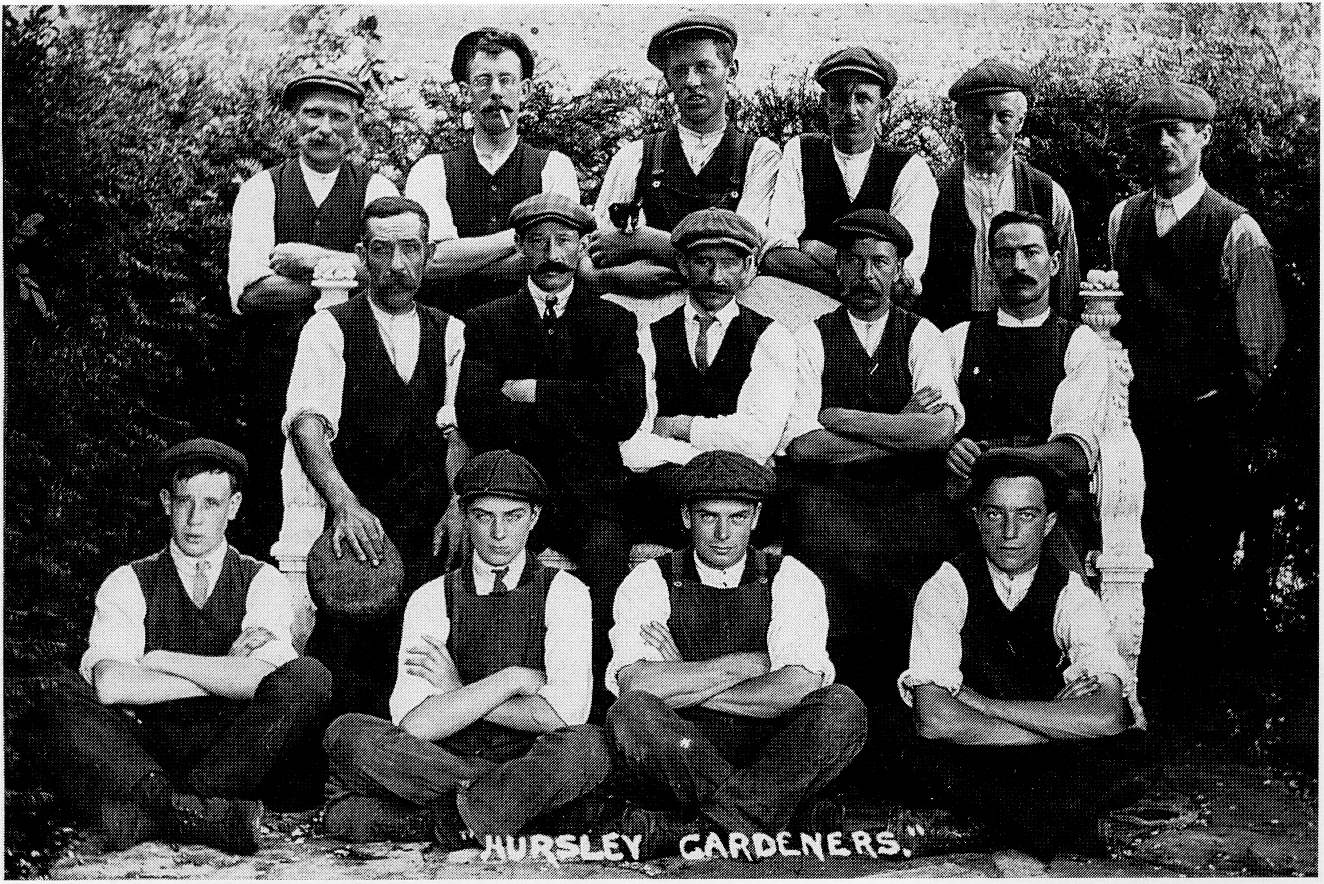 Hursley Park gardeners c. 1910. Photo: S Thorne.
Hursley Park gardeners c. 1910. Photo: S Thorne.